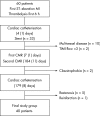Microvascular perfusion 1 week and 6 months after myocardial infarction by first-pass perfusion cardiovascular magnetic resonance imaging
- PMID: 16803939
- PMCID: PMC1861306
- DOI: 10.1136/hrt.2005.077305
Microvascular perfusion 1 week and 6 months after myocardial infarction by first-pass perfusion cardiovascular magnetic resonance imaging
Abstract
Objective: To characterise the evolution of myocardial perfusion during the first 6 months after myocardial infarction by first-pass perfusion cardiovascular magnetic resonance imaging (CMR) and determine its significance.
Design: Prospective cohort design.
Setting: Single-centre study in a teaching hospital in Spain.
Patients: 40 patients with a first ST-elevation myocardial infarction, single-vessel disease and thrombolysis in myocardial infarction (TIMI) grade 3 flow (stent in 33 patients) underwent rest and low-dose dobutamine CMR 7 (SD 1) and 184 (SD 11) days after infarction. Microvascular perfusion was assessed at rest by visual assessment and quantitative analysis of first-pass perfusion CMR. Of the 640 segments, 290 segments subtended by the infarct-related artery (IRA) were focused on.
Results: Both 1 week and 6 months after infarction, segments with normal perfusion showed more wall thickening, contractile reserve and wall thickness, and less transmural necrosis, p <0.05 in all cases. Of 76 hypoperfused segments at the first week, 47 (62%) normalised perfusion at the sixth month. However, 42 segments (14% of the whole group) showed chronic abnormal perfusion; these segments showed worse CMR indices in the late phase (p<0.05 in all cases).
Conclusions: In patients with an open IRA, more than half of the segments with abnormal perfusion at the first week are normally perfused after six months. First-pass perfusion CMR shows that in a small percentage of segments, abnormal perfusion may become a chronic phenomenon-these areas have a more severe deterioration of systolic function, wall thickness, contractile reserve and the transmural extent of necrosis.
Conflict of interest statement
Competing interests: None.
Similar articles
-
Characterization of microvascular dysfunction after acute myocardial infarction by cardiovascular magnetic resonance first-pass perfusion and late gadolinium enhancement imaging.J Cardiovasc Magn Reson. 2006;8(6):831-7. doi: 10.1080/10976640600778049. J Cardiovasc Magn Reson. 2006. PMID: 17060106
-
Resting myocardial blood flow is impaired in hibernating myocardium: a magnetic resonance study of quantitative perfusion assessment.Circulation. 2005 Nov 22;112(21):3289-96. doi: 10.1161/CIRCULATIONAHA.105.549170. Epub 2005 Nov 14. Circulation. 2005. PMID: 16286587 Clinical Trial.
-
Evolution of 5 cardiovascular magnetic resonance-derived viability indexes after reperfused myocardial infarction.Am Heart J. 2007 Apr;153(4):649-55. doi: 10.1016/j.ahj.2006.12.023. Am Heart J. 2007. PMID: 17383307
-
Current perspective the expanding role of cardiovascular magnetic resonance in the identification of myocardial viability.Ital Heart J. 2005 Aug;6(8):619-28. Ital Heart J. 2005. PMID: 16161494 Review.
-
Cardiac MRI assessment of myocardial perfusion.Future Cardiol. 2014 May;10(3):349-58. doi: 10.2217/fca.14.18. Future Cardiol. 2014. PMID: 24976472 Free PMC article. Review.
Cited by
-
Function of remote non-infarcted myocardium after STEMI: analysis with cardiovascular magnetic resonance.Int J Cardiovasc Imaging. 2012 Dec;28(8):2057-64. doi: 10.1007/s10554-012-0014-8. Epub 2012 Jan 20. Int J Cardiovasc Imaging. 2012. PMID: 22261997
-
Microvascular obstruction in patients with non-ST-elevation myocardial infarction: a contrast-enhanced cardiac magnetic resonance study.Int J Cardiovasc Imaging. 2014 Aug;30(6):1087-95. doi: 10.1007/s10554-014-0430-z. Epub 2014 Apr 30. Int J Cardiovasc Imaging. 2014. PMID: 24781031
-
Dynamics and implications of circulating anti-angiogenic VEGF-A165b isoform in patients with ST-elevation myocardial infarction.Sci Rep. 2017 Aug 30;7(1):9962. doi: 10.1038/s41598-017-10505-9. Sci Rep. 2017. PMID: 28855597 Free PMC article.
-
Subclinical dysfunction of remote myocardium is related to high NT-proBNP and affects global contractility at follow-up, independently of infarct area.Front Cardiovasc Med. 2022 Dec 19;9:997821. doi: 10.3389/fcvm.2022.997821. eCollection 2022. Front Cardiovasc Med. 2022. PMID: 36601063 Free PMC article.
-
MR findings of microvascular perfusion in infarcted and remote myocardium early after successful primary PCI.PLoS One. 2018 Nov 9;13(11):e0206723. doi: 10.1371/journal.pone.0206723. eCollection 2018. PLoS One. 2018. PMID: 30412607 Free PMC article. Clinical Trial.
References
-
- Braunwald E. Reperfusion therapy for acute myocardial infarction: historical context and future promise. Eur Heart J 20024E10–E14.
-
- Bodi V, Sanchis J, Losada A.et al Usefulness of quantitative intravenous myocardial contrast echocardiography to analyze microvasculature perfusion in patients with a recent myocardial infarction and an open infarct‐related artery: comparison with intracoronary myocardial contrast echocardiography. Eur J Echocardiogr 20056164–174. - PubMed
Publication types
MeSH terms
LinkOut - more resources
Full Text Sources
Medical






